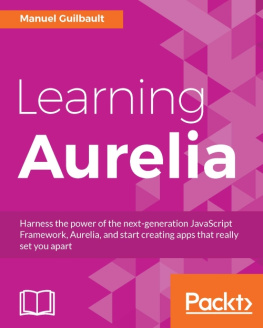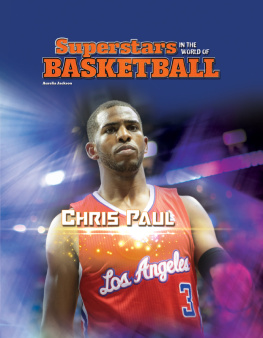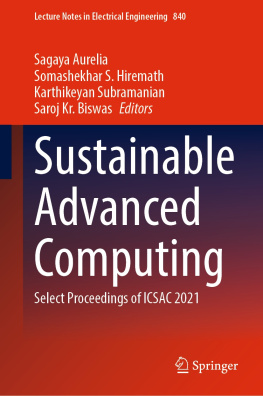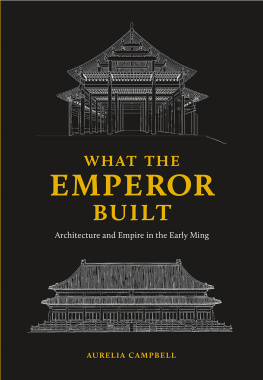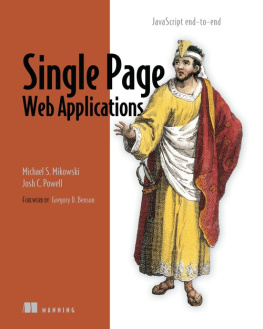Learning Aurelia
Copyright 2016 Packt Publishing
All rights reserved. No part of this book may be reproduced, stored in a retrieval system, or transmitted in any form or by any means, without the prior written permission of the publisher, except in the case of brief quotations embedded in critical articles or reviews.
Every effort has been made in the preparation of this book to ensure the accuracy of the information presented. However, the information contained in this book is sold without warranty, either express or implied. Neither the author(s), nor Packt Publishing, and its dealers and distributors will be held liable for any damages caused or alleged to be caused directly or indirectly by this book.
Packt Publishing has endeavored to provide trademark information about all of the companies and products mentioned in this book by the appropriate use of capitals. However, Packt Publishing cannot guarantee the accuracy of this information.
First published: December 2016
Production reference: 1221216
Published by Packt Publishing Ltd.
Livery Place
35 Livery Street
Birmingham
B3 2PB, UK.
ISBN 978-1-78588-967-7
www.packtpub.com
Credits
Author Manuel Guilbault | Copy Editor Safis Editing |
Reviewer Matthew James Davis | Project Coordinator Sheejal Shah |
Commissioning Editor Ashwin Nair | Proofreader Safis Editing |
Acquisition Editor Smeet Thakkar | Indexer Tejal Daruwale Soni |
Content Development Editor Parshva Sheth | Graphics Abhinash Sahu |
Technical Editor Prashant Mishra | Production Coordinator Shantanu N. Zagade |
About the Author
Manuel Guilbault is a Canadian-born, France-based developer, and works as the CTO of an online marketing startup. After studying software engineering in Montreal, he worked as a full-stack web developer for well-known clients in the press industry, automotive industry, and financial sector for 10 years.
An Aurelia enthusiast since day one, he closely followed the development of the framework, while modestly contributing to it and blogging and talking about it. He is an active member of the Paris Aurelia meetup group.
Passionate about software craftsmanship, agility, and lean principles, he loves to learn and debate about how we do things, why we do them this way, and how they can be improved.
Id like to thank my friends and family for their tremendous support and enthusiasm for this project. Kudos to Geoffrey for his patience, for all the times I let him handle business issues so I could work on this book, and to Frank for the review and advice. Lastly, my gratitude to my wife, Caroline, who lovingly went through the countless weekends during which I researched and wrote instead of spending time with her.
About the Reviewer
Matthew James Davis is a friendly guy who loves his family and enjoys writing exceptional code. He has been involved with Aurelia since its inception and regularly writes Aurelia-related blogs on his website, http://davismj.me/.
Id like to thank my two mentors in the software world: Brian Hearn and Rob Eisenberg.
www.PacktPub.com
For support files and downloads related to your book, please visit www.PacktPub.com.
Did you know that Packt offers eBook versions of every book published, with PDF and ePub files available? You can upgrade to the eBook version at www.PacktPub.com and as a print book customer, you are entitled to a discount on the eBook copy. Get in touch with us at service@packtpub.com for more details.
At www.PacktPub.com, you can also read a collection of free technical articles, sign up for a range of free newsletters and receive exclusive discounts and offers on Packt books and eBooks.
https://www.packtpub.com/mapt
Get the most in-demand software skills with Mapt. Mapt gives you full access to all Packt books and video courses, as well as industry-leading tools to help you plan your personal development and advance your career.
Why subscribe?
- Fully searchable across every book published by Packt
- Copy and paste, print, and bookmark content
- On demand and accessible via a web browser
Customer Feedback
Thank you for purchasing this Packt book. We take our commitment to improving our content and products to meet your needs seriouslythat's why your feedback is so valuable. Whatever your feelings about your purchase, please consider leaving a review on this book's Amazon page. Not only will this help us, more importantly it will also help others in the community to make an informed decision about the resources that they invest in to learn.You can also review for us on a regular basis by joining our reviewers' club. If you're interested in joining, or would like to learn more about the benefits we offer, please contact us : customerreviews@packtpub.com.
Preface
The Web evolves very quickly. Technologies come and go, and every couple of years, new ideas emerge and become widely popular, only to be replaced by something else after a while.
If youve been doing web development for many years, chances are youve seen this cycle go on. Things such as Prototype, and then jQuery, were widely popular in the mid-2000s, and are still used on many projects nowadays.
Then, with the performance of browsers and JavaScript engines getting better and better, the last decade or so have seen the emergence of many full-blown, JavaScript-based frontend frameworks such as Angular and Durandal. More recently, modern frameworks based on different concepts or paradigms such as React and Polymer have gained a lot of popularity.
Aurelia is such a modern framework. The brainchild of Rob Eisenberg, the father of Durandal, it is based on cutting edge Web standards, and is built on modern software architecture concepts and ideas, to offer a powerful toolset and an awesome developer experience.
What this book covers
, Getting Started , walks you through the basic concepts around Aurelia, and explains how to set up your environment and start a project.
, Layout, Menu, and Getting Familiar , goes further into the concepts at the core of Aurelia, such as dependency injection, logging, and the plugin system. It also explains how to create the main layout and navigation menu of a multi-paged application.
, Displaying Data , guides you through the templating and data-binding system, so you can build complex views.
, Forms, and How to Validate Them , builds on the previous chapter by showing how to build rich forms and how to use Aurelias flexible and powerful validation mechanism. It also explores different edition models, such as inline edition or dialog-based edition.
, Making Reusable Components , shows you how to build reusable Aurelia components, such as custom HTML elements and attributes. It also explains how to leverage some cutting edge Web Standards supported by Aurelia, such as the Shadow DOM and content projection.

